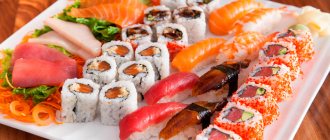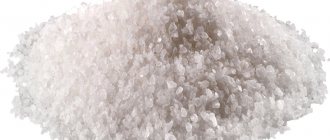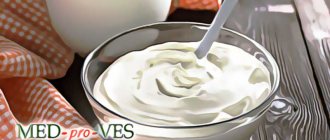It is difficult to meet a person who has never tried sushi. People who adhere to vegetarian views have completely replaced meat with rolls. All over the world, traditional cuisine of Asian countries is associated with health and eternal youth, and is considered light and dietary.
In 2021, scientists found that the exotic dish is not so healthy. Experts conducted experiments on the purity of ingredients in the best establishments around the world. As a result, seven reasons were identified why it is better to give up sushi!
Low quality fish sushi
Fish is good for the body: it is full of vitamins and microelements, and fish oil is a natural food supplement. But this fact applies only to fish that are caught in the seas and oceans.
In the restaurant business, food purchases are made at low prices. Salmon, tuna and other types of fish that are bought by restaurants are grown on artificial fish farms. “Children” of farms are much more harmful than natural ones for several reasons:
- in production, fish receive a huge dose of antibiotics;
- salmon and tuna are fed with special feed;
- The water in the pools is rarely changed, so the fish defecate and live in the same water for a long time.
When ordering sushi at home via the Internet, you cannot see what kind of fish is used during preparation. There is no certainty that the fish is 100% fresh, especially if it has been smoked or baked (so-called “hot sushi”).
A portion of mercury and arsenic
Fish may contain dangerous substances: mercury and arsenic. The harm of these chemicals to the human body has been known for a long time.
- Mercury harms the immune, nervous and digestive systems, negatively affects the eyes, kidneys, lungs and skin, including death.
- Arsenic is a poison. When poisoned, all organs are affected, but especially the nervous and digestive systems. It is worth noting that arsenic not only disrupts the functioning of organs and systems, but also affects cellular development and processes.
Reason No. 3 – Presence of high-calorie sauces and mayonnaise
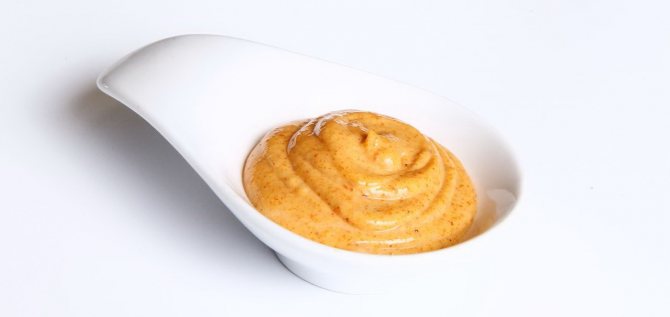
No matter how sad it may sound, various sauces and mayonnaise are not rare guests in our favorite rolls. To make the filling of the rolls more tasty, not dry, and the roll itself not to crumble, they came up with adding these completely unnecessary ingredients to our body, from which there is no benefit, but on the contrary - only troubles. Also, creamy creamy sauces are sometimes added in addition to soy sauce, which also significantly increases the calorie content of sushi .
These are the main reasons that make sushi a high-calorie product. The calorie content of sushi depends primarily on these three components. But there are ways that can help reduce the calorie content of sushi and make it not only a low-calorie dish, but also healthy.
Marine parasites
These are the most common helminths that infect fish and many other seafood.
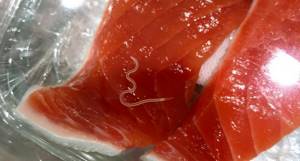
Marine parasites, especially if diagnosed too late, can cause serious health problems, ranging from headaches to cancer. Externally, fish and seafood infected with parasitic pathologies are no different from healthy ones.
You can protect fish by freezing it at a temperature of -40 degrees for 3 hours. However, in this case its taste characteristics will be lost, so this practice practically does not occur. According to the rules of Japanese cooking, fish that has not undergone any processing is put into rolls and sushi.
Tip 2
If you don’t have such a “golden” establishment in your city, then I advise you to choose sushi that does not contain any cheese at all. That is, give preference to sushi with salmon, tuna, shrimp, octopus, scallops, chicken fillet and of course vegetable rolls. This way you will kill three birds with one stone:
- Protect yourself from extra unnecessary calories.
- Enjoy your favorite dish.
- Destroy the stereotype “Sushi is bad for your figure!”
Harmful Ingredients
Sushi and rolls are incomplete without white rice and soy sauce. Unfortunately, the sauce contains a high percentage of sodium. It causes problems with the cardiovascular system. A person's blood pressure rises and the risk of a heart attack increases.
Soy sauce is prepared according to a complex recipe. The price of real soy sauce is several times higher than the price of the liquid that many are used to seeing in restaurants. Unscrupulous manufacturers do not follow the traditional recipe, adding GMOs and other harmful ingredients to the sauce. Soy sauce can be replaced with coconut aminos.
Taking the harmful ingredients even further, white rice is rich in refined carbohydrates. The body spends entire reserves of useful substances and energy on their processing. In addition, carbohydrates cause allergies and liver problems.
Reason No. 2 – Presence of cheese in the filling

You can learn all about the benefits of cheese from an article dedicated entirely to cheeses: The benefits of cheese in fitness nutrition. Is it possible to eat cheese while losing weight?
Traditional rolls mostly use Philly cheese... or no, not that... - Philly cheese MUST be used! This cheese has an average fat content of 25-35%, which means that this cheese can be safely consumed in moderate doses by people who watch their figure, but there is one “BUT”.
The policy of not all sushi restaurants, and especially numerous online sushi deliveries, is to use this wonderful cheese in the preparation of rolls, which we, dear girls, are, in principle, allowed to leave in our dietary intake. Philadelphia is not the most economical cheese option for sushi producers, so unscrupulous establishments replace this type of cheese with cheaper options, which are often much higher in calories, and the fat content in them increases by at least 2, or even 3 times. Cheap analogues of Philadelphia may not differ much in taste (especially when mixing the flavors of rice, fish, seafood, wasabi, ginger, soy sauce, this is not so easy to notice), but in terms of chemical composition and usefulness, believe me, they are VERY different. But there is a way out of this unpleasant situation, which you will learn about below.
Imitation wasabi
As journalists from The Washington Post write, the wasabi in many local restaurants has little in common with real wasabi in Japan. Many sushi markets, under the guise of wasabi, put nothing more than ordinary horseradish with green dye and mustard.
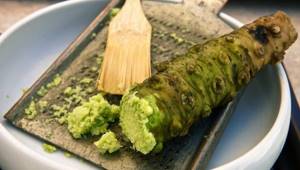
The imitation wasabi comes in large industrial packages as a powder, and before serving it, chefs dissolve the powder in water to form a simple hot paste. Why is that? Everything is logical: one kilogram of the real rhizome of the plant from which it is prepared costs at least 120 dollars per kilogram! This is an uncompetitive price.
Reason #1 – Presence of rice

Rice is a rather tricky grain. Many people think that rice is a low-calorie porridge and that it is good for weight loss, but this is true. You can read more about rice in the article “The benefits of rice and semolina for the body. The whole truth about porridge. Part 2".
Here I will only say that 100 g of rice contains as many as 80 g of carbohydrates , of which 50.5 g is pure starch Protein – 8.9 g, fat – 0.5 g. As you can see, rice consists of 80% carbohydrates, and when losing weight we must minimize carbohydrates, so very frequent consumption of sushi, which contains a large amount of rice, will lead to It definitely won’t do your figure any good.
breeding ground for bacteria
Research has been conducted in Norway. The results shocked scientists: out of 100% of samples, 71% were found to contain bacteria dangerous to the body. They can cause problems with the intestines, skin and general health.
Scientists identified temperature disturbances during transportation as the main reason for the low quality of fish. Even slight warming leads to the appearance of bacteria. If you eat sushi made from fresh fish, there is a high chance that you will get dangerous bacteria along with your food.
Healthy alternatives to sushi and rolls
There are healthy alternatives to sushi and rolls. They will cause minimal harm to health and will be much tastier than a traditional Japanese dish.
- Making your own rolls. You will be able to purchase products for the rolls yourself and will be confident in their authenticity and freshness.
- At restaurants, ask for brown rice instead of white. It is much healthier than traditional rice.
- Eat rolls with vegetables. They are safer than red fish.
- Skip the wasabi. Leave only the ginger, it is much healthier than fake wasabi.
- Don't use soy sauce. It can be replaced with coconut amino acids. They have less sodium and enhance the flavor of the rolls.
- Sashimi is fish without rice or sauce. You won't get a ton of substances that are useless for the body. There is a risk of harm from stale fish, but it is minimal.
By giving up sushi and rolls, you really limit the risk of poisoning from dangerous ingredients! What do you think about this? Write in the comments.
Is it possible to eat sushi and is it healthy?
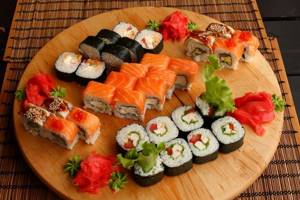
Sushi is a favorite product of many. A dish of traditional Japanese cuisine, it very quickly spread to other countries.
A wonderful combination of fresh fish, rice and other ingredients, seasoned with spicy wasabi and ginger. Rolls gained mass popularity in the 80s of the 20th century, and are currently one of the most popular among dishes of other cuisines.
A wide variety of sushi allows you to choose the option to suit your taste. From the simplest to the more complex, with fish, vegetables, cheese and many other ingredients, sushi amazes the imagination and awakens the desire to try all new types.
Rolls are one of the types of sushi. They are often also called sushi rolls. The cooking technology itself fully justifies this name. The whole point is that a sheet of noria with the filling embedded in it is wrapped in a tight tube, which is then cut into 6 or 8 pieces, hence the name. Like sushi, rolls come in a wide variety of varieties, depending on the ingredients.
The harm and benefits of sushi and rolls
The main qualities of sushi and rolls are determined by the components they contain. First of all, it is rice, noria leaf and fish of different varieties (maybe salmon, tuna, eel, etc.). Some options involve not fish, but, for example, vegetable or fruit filling.
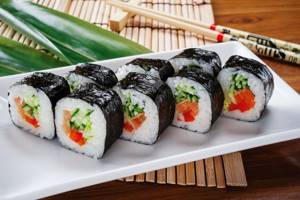
In general, rolls and sushi are healthy food. The fish varieties included in their composition are rich in vitamins and microelements, Omega-3. All elements of sushi are well absorbed by the body and contribute to the normal functioning of internal organs. Rice is a product valuable in microelements and is recognized as dietary. It satisfies hunger in a matter of minutes, and the fiber it contains promotes beneficial digestion.
Nori leaf is a good source of iodine. At the same time, considering that most sushi options are not heat-treated, all their beneficial properties are perfectly preserved.
Sushi and rolls are one of the product options, the advantages of which can also become its disadvantages. So, if the raw fish present in the composition does not meet the required quality, the risk of a bad effect on internal organs (and especially the liver) increases several times.
The indispensable seasoning of sushi - sauce - actually contains a large amount of salt, so, if possible, it is better not to overuse it.
Rolls and sushi for children
Rolls and sushi are delicious products that many people want to try, including children. In fact, given the risk of possible infections due to eating raw fish, it is better not to risk it and not give Japanese cuisine to children under 7-10 years of age. Rolls and sushi for nursing mothers and diabetics
As for nursing mothers and diabetics, they can eat rolls, but only with extreme caution, buying the product in reliable, recommended places. If the fish is prepared in accordance with all requirements, then its effect on the body will be positive. The phosphorus and fatty acids it contains will only be beneficial.
Antiseptic effects of wasabi, its antimicrobial effect; iodine contained in noria seaweed, B vitamins; amino acids in soy sauce - all this can in no way harm a weakened body, but on the contrary, will only support it. Ginger will also be useful for lactating women and diabetics, as it normalizes digestive processes and helps relieve inflammation.
Rice for sushi
Many people wonder whether they can make sushi and rolls themselves. In general, a few attempts will be enough to master the technique of wrapping the product. The situation with the ingredients will be somewhat different, and it’s worth talking about rice separately.
You can prepare the perfect sushi rice by following special recipes. Their main secret is a special rice dressing, while the cereal itself is regular round grain rice, not special. It is not necessary to rinse it after cooking.
Shelf life of sushi
A sharp smell reminiscent of ammonia will help determine the unsuitability of sushi. In this case, the rolls are most likely already spoiled. In general, the permissible storage time for rolls is up to 24 hours in the refrigerator.
Therefore, if you want to take them with you to the country or to nature, you should definitely place the product in a portable freezer. And when storing rolls in a regular refrigerator, you should know that they taste better on a flat dish under a plastic bag than in a regular container.
Recently, rolls have become more and more popular. In this regard, many establishments are opening that meet the requirements. At the same time, unscrupulous cafes are opening. That is why you should be careful when choosing rolls and choose only proven places.
